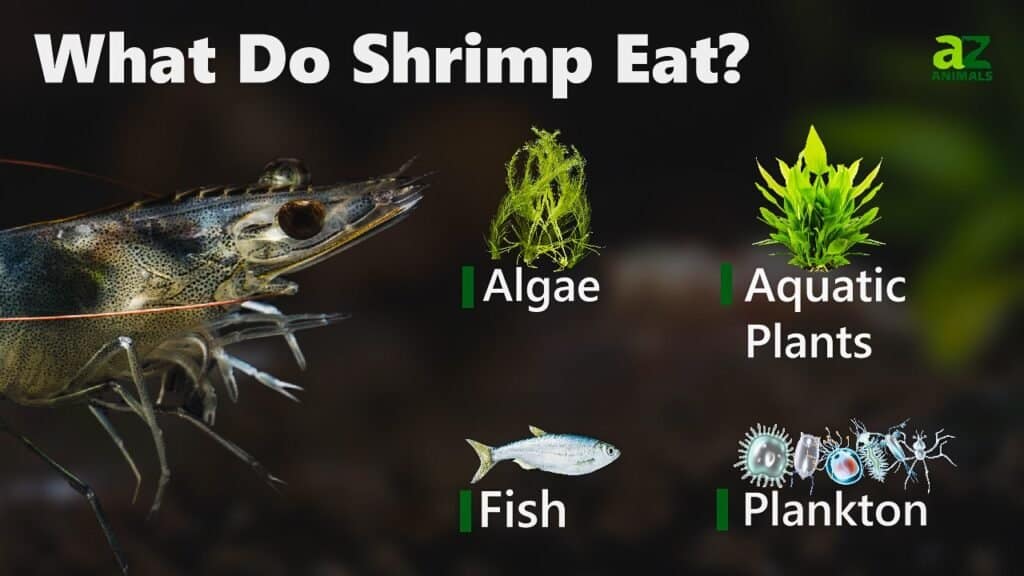Shrimps are crustaceans with long slender bodies. Their muscular abdomens come in handy during locomotion. It’s important to note that most shrimp species can eat anything, but some have developed special ways to eat.
Algae, mollusks, other shrimp, trash, and a wide range of parasitic organisms are common foods for shrimp.
Plankton often forms an important part of shrimp diets. But what exactly is plankton, and how do shrimp eat it? Let’s take a closer look.
Plankton refers to tiny marine organisms that drift along ocean currents. Unable to swim against currents, they provide a vital food source for many larger animals. There are two main types of plankton:
- Phytoplankton – Microscopic plants like algae that can photosynthesize.
- Zooplankton – Microscopic animals like protozoans and crustaceans.
Phytoplankton and zooplankton occur in huge numbers, containing a variety of vitamins, minerals, fatty acids, and other nutrients. This makes them an attractive food source for shrimp and other species.
Do Shrimp Eat Plankton?
Yes, shrimp readily consume both phytoplankton and zooplankton. Plankton forms a major part of the diet for many shrimp species.
For example, pink shrimp larvae primarily feed on plankton. Juvenile and adult pink shrimp are omnivores that eat a variety of foods including plankton, algae, mollusks, worms, and detritus.
Other shrimp like the Gabon shrimp also filter feed on plankton along with algae and insect larvae Cleaner shrimp may pick plankton and parasites off fish
So plankton, especially zooplankton like copepods, often provides the main protein source for shrimp. The exact diet varies by species, habitat, and life stage. But plankton frequently occurs in wild shrimp diets.
How Do Shrimp Eat Plankton?
Plankton is microscopic so how do shrimp locate and consume it?
Shrimp have several adaptations that allow them to eat plankton:
- Antennae – Shrimp wave their long antennae through the water to sense plankton.
- Appendages – Mouthparts and legs trap and direct plankton towards the mouth.
- Gills – Modified gills filter tiny plankton from the water.
- Direct grazing – Shrimp may simply graze on surfaces covered in phytoplankton.
So shrimp use a combination of filtering, trapping, and direct consumption to feed on plankton. They detect plankton using chemical cues rather than vision.
Can Shrimp Survive on Plankton Alone?
While plankton provides important nutrition, shrimp depend on other foods as well. They likely cannot survive on plankton alone for long.
In aquariums, a plankton-only diet will not meet all of a shrimp’s nutritional needs. They require calcium and additional protein from sources like algae wafers, blanched vegetables, and fish food.
Still, adding plankton provides a great supplementary food source. Home aquarists can culture phytoplankton to feed shrimp and fish.
Potential Downsides of Plankton for Shrimp
While nutritious, plankton does come with some risks:
- Excess phytoplankton can reduce oxygen levels at night as the plants respire. This may suffocate shrimp.
- Too much zooplankton like Daphnia can outcompete shrimp for food. It may also alter water chemistry.
- Plankton die-offs can cause ammonia spikes. Good tank maintenance helps prevent this.
So aquarists should feed phytoplankton in moderation to avoid these issues. Still, it makes an excellent addition to a varied shrimp diet when maintained properly.
Frequently Asked Questions
Do shrimp eat algae?
Yes, shrimp eat several types of algae, including string algae, green algae, brown algae, and blue-green algae. Algae provides an excellent source of protein and calcium for shrimp.
What other foods do shrimp eat?
In addition to plankton and algae, shrimp eat:
- Decaying plants
- Fish waste and carcasses
- Aquatic invertebrates like worms
- Biofilm
- Blanched vegetables
- Sinking wafers
- Fish and shrimp pellets
Shrimp are omnivorous opportunistic feeders, consuming a wide variety of foods.
Can too much plankton harm shrimp?
Yes, excessive phytoplankton can reduce oxygen levels and alter water chemistry. Large zooplankton populations may outcompete shrimp for food. Moderation is key when feeding plankton to shrimp.
Conclusion
Plankton provides an excellent supplementary food source for shrimp. Both phytoplankton and zooplankton deliver vital nutrients that shrimp cannot get from other foods alone. While shrimp eat more than just plankton, it often forms a major part of their diet in the wild. When maintained properly, adding plankton can significantly boost shrimp health.

What Do Shrimp Eat in Freshwater?
Freshwater shrimp primarily eat tiny particles (usually of decaying algae) at the bottom of the body of water.
- This “trash” is thrown away by these shrimp in the water, which makes the environment much cleaner.
- First, they use the tips of their claws to scrape these particles off the ground, and then they bring them to their mouths.
- Finally, keep in mind that the freshwater shrimp that eat algae every day help recycle the organic matter in the water.
How Often Do Shrimp Eat?
Shrimps will feed as frequently as they can to realize their daily energy needs. When they feel the need to, these crustaceans can be found searching for food in the waterways where they live.
